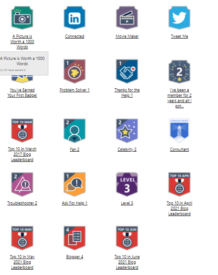Most Used FetchXML Queries in Dynamics 365 CRM
FetchXML is a XML based query language used in Microsoft Dynamics 365 CRM to fetch data. FetchXML is capable of doing many things as explained below.
- Can only be used to retrieve data not able to perform CUD (Create/Update/Delete) operation.
- Can be used in JavaScript to retrieve data in client side also used in server side code to retrieve data.
- Can perform Aggregations such as Sum, Average, Minimum, Maximum, Count(*), Count(attributename).
- Supports Linked entity data retrieval with conditions, filters, GroupBy, Sorting
- Can fetch 5000 record data at a time and supports paging concept to fetch more records page by page .
- Can be saved in userquery entity as user owned view and savedquery entity as organization owned view.
- Can also be used in SSRS query in Reporting.
- Supports aliased name for attributes retrieved.
- Supports similar query capabilities as query expressions.
- Can be executed by using the RetrieveMultiple method.
- Can be downloaded/saved from Advance Find query.
Here is a list of sample FetchXML Queries given below.
Everyday we use fetchXML in development. So here i have given a list of ready-made fetchXMLs which you can use by modifying the code as per your business requirement. FetchXML query should validated by the xsd schema.
Retrieve all attributes of account entity[code lang=”xml”] |
Retrieve selected attributes of account entity[code lang=”xml”] |
Retrieve records of account entity with filter condition[code lang=”xml”] |
Retrieve contract records using linkedentity with customer using filter condition in linked entity[code lang=”xml”] |
Limit the Maximum (Lets Say 5)Number Of Records to be retrieved in contact entity.[code lang=”xml”] |
Limit the Maximum (Lets Say 5)Number Of Records to be retrieved in contact entity.[code lang=”xml”] |
Use of Inner Join in FetchXML[code lang=”xml”] |
Use of Left Outer Join in FetchXML[code lang=”xml”] |
Use Avarage Aggregate in FetchXML[code lang=”xml”] |
Count No. of records retrieved in FetchXML[code lang=”xml”] |
Using “older than” clauses for date and time values in FetchXML Query[code lang=”xml”] |
fiscal-period FetchXML Query[code lang=”xml”] |
Order by in FetchXML Query[code lang=”xml”] |
Order by in FetchXML Query[code lang=”xml”] |
List of Operators used in FetchXML are given below.
| FetchXML Operator | ConditionOperator | Description |
| like | BeginsWith | The string occurs at the beginning of another string. |
| between | Between | The value is between two values. |
| like | Contains | The string contains another string. |
| not-like | DoesNotBeginWith | The string does not begin with another string. |
| not-like | DoesNotContain | The string does not contain another string. |
| not-like | DoesNotEndWith | The string does not end with another string. |
| like | EndsWith | The string ends with another string. |
| eq | Equal | The values are compared for equality. |
| eq-businessid | EqualBusinessId | The value is equal to the specified business ID. |
| eq-userid | EqualUserId | The value is equal to the specified user ID. |
| eq-userteams | EqualUserTeams | The record is owned by teams that the user is a member of. |
| ge | GreaterEqual | The value is greater than or equal to the compared value. |
| gt | GreaterThan | The value is greater than the compared value. |
| in | In | TheThe value exists in a list of values. |
| in-fiscal-period | InFiscalPeriod | The value is within the specified fiscal period. |
| in-fiscal-period-and-year | InFiscalPeriodAndYear | The value is within the specified fiscal period and year. |
| in-fiscal-year | InFiscalYear | The value is within the specified year. |
| in-or-after-fiscal-period-and-year | InOrAfterFiscalPeriodAndYear | The value is within or after the specified fiscal period and year. |
| in-or-before-fiscal-period-and-year | InOrBeforeFiscalPeriodAndYear | The value is within or before the specified fiscal period and year. |
| last-seven-days | Last7Days | The value is within the last seven days including today. |
| last-fiscal-period | LastFiscalPeriod | The value is within the last fiscal period. |
| last-fiscal-year | LastFiscalYear | The value is within the last fiscal year. |
| last-month | LastMonth | The value is within the last month including first day of the last month and last day of the last month. |
| last-week | LastWeek | The value is within the previous week including Sunday through Saturday. |
| last-x-days | LastXDays | The value is within last X days. |
| last-x-fiscal-periods | LastXFiscalPeriods | The value is within the last X (specified value) fiscal periods. |
| last-x-fiscal-years | LastXFiscalYears | The value is within the last X (specified value) fiscal periods. |
| last-x-hours | LastXHours | The value is within the last X hours. |
| last-x-months | LastXMonths | The value is within the last X (specified value) months. |
| last-x-weeks | LastXWeeks | The value is within the last X (specified value) weeks. |
| last-x-years | LastXYears | The value is within the last X years. |
| last-year | LastYear | The value is within the previous year. |
| le | LessEqual | The value is less than or equal to the compared value. |
| lt | LessThan | The value is less than the compared value. |
| like | Like | The character string is matched to the specified pattern. |
| next-seven-days | Next7Days | The value is within the next seven days. |
| next-fiscal-period | NextFiscalPeriod | The value is within the next fiscal period. |
| next-fiscal-year | NextFiscalYear | The value is within the next fiscal year. |
| next-month | NextMonth | The value is within the next month. |
| next-week | NextWeek | The value is within the next week. |
| next-x-days | NextXDays | The value is within the next X (specified value) days. |
| next-x-fiscal-periods | NextXFiscalPeriods | The value is within the next X (specified value) fiscal period. |
| next-x-fiscal-years | NextXFiscalYears | The value is within the next X (specified value) fiscal years. |
| next-x-hours | NextXHours | The value is within the next X (specified value) hours. |
| next-x-months | NextXMonths | The value is within the next X (specified value) months. |
| next-x-weeks | NextXWeeks | The value is within the next X weeks. |
| next-x-years | NextXYears | The value is within the next X years. |
| next-year | NextYear | The value is within the next year. |
| not-between | NotBetween | The value is not between two values. |
| ne | NotEqual | The two values are not equal. |
| ne-businessid | NotEqualBusinessId | The value is not equal to the specified business ID. |
| ne-userid | NotEqualUserId | The value is not equal to the specified user ID. |
| not-in | NotIn | The given value is not matched to a value in a subquery or a list. |
| not-like | NotLike | The character string does not match the specified pattern. |
| not-null | NotNull | The value is not null. |
| ne | NotOn | The value is not on the specified date. |
| null | Null | The value is null. |
| olderthan-x-months | OlderThanXMonths | The value is older than the specified number of months. |
| on | On | The value is on a specified date. |
| on-or-after | OnOrAfter | The value is on or after a specified date. |
| on-or-before | OnOrBefore | The value is on or before a specified date. |
| this-fiscal-period | ThisFiscalPeriod | The value is within the current fiscal period. |
| this-fiscal-year | ThisFiscalYear | The value is within the current fiscal year. |
| this-month | ThisMonth | The value is within the current month. |
| this-week | ThisWeek | The value is within the current week. |
| this-year | ThisYear | The value is within the current year. |
| today | Today | The value equals today’s date. |
| tomorrow | Tomorrow | The value equals tomorrow’s date. |
| yesterday | Yesterday | The value equals yesterday’s date. |
List of older than clauses in a FetchXML expression
| Older than X minutes |
| Older than X hours |
| Older than X days |
| Older than X weeks |
| Older than X months |
| Older than X years |
How to Retrieve Data using Fetch XML in server side (Sample given below)
[code lang=”xml”]
// Retrieve all accounts owned by the user with read access rights to the accounts and
// where the last name of the user is not Cannon.
string varFetchXML = @"
<fetch mapping=’logical’>
<entity name=’account’>
<attribute name=’accountid’/>
<attribute name=’name’/>
<link-entity name=’systemuser’ to=’owninguser’>
<filter type=’and’>
<condition attribute=’lastname’ operator=’ne’ value=’Cannon’ />
</filter>
</link-entity>
</entity>
</fetch> ";
EntityCollection result =
_serviceProxy.RetrieveMultiple(new FetchExpression(varFetchXML));
foreach (var c in result.Entities)
{
System.Console.WriteLine(c.Attributes["name"]);
}
[/code]
How to Retrieve Data using Fetch XML in client side using WebAPI(Sample given below)
[code lang=”xml”]
var fetchXml =
"<fetch version=’1.0′ output-format=’xml-platform’ mapping=’logical’ distinct=’false’>"+
"<entity name=’account’>"+
"<attribute name=’name’ />"+
"<attribute name=’primarycontactid’ />"+
"<attribute name=’telephone1′ />"+
"<attribute name=’accountid’ />"+
"<order attribute=’name’ descending=’false’ />"+
"<filter type=’and’>"+
"<condition attribute=’name’ operator=’like’ value=’C%’ />"+
"</filter>"+
"</entity>"+
"</fetch>";
var encodedFetchXml = encodeURI(fetchXml);
var queryPath = "/api/data/v8.0/accounts?fetchXml=" + encodedFetchXml;
var requestPath = Xrm.Page.context.getClientUrl() + queryPath;
var req = new XMLHttpRequest();
req.open("GET", requestPath, true);
req.setRequestHeader("Accept", "application/json");
req.setRequestHeader("Content-Type", "application/json; charset=utf-8");
req.onreadystatechange = function ()
{
if (this.readyState === 4)
{
this.onreadystatechange = null;
if (this.status === 200)
{
var returned = JSON.parse(this.responseText);
var results = returned.value;
for (var i = 0; i < results.length; i++)
{
var accountName = results[i]["name"];
var primaryContactId = results[i]["_primarycontactid_value"];
var telephone = results[i]["telephone1"];
var accountId = results[i]["accountid"];
//TODO: Implement logic for handling results as desired
}
}
else
{
alert(this.statusText);
}
}
};
req.send();
[/code]
Related Links:
Create a SSRS report using FetchXML.
Retrieve More than 5000 record using FetchXML Paging.
FetchXML V/S Query Expression
| FetchXML | Query Expression |
| Easy to construct FetchXML Query using out-of-the-box Advance Find visual tool | Manually need to write the code to declare objects of Query Expression, Filters, Conditions, attributes etc. |
| Can be used in both client side and server side data retrieval | Can only be used in server side code data retrieval such as plugins, custom workflows, custom .net components |
| Get Optionset Text Directly | NO Direct retrieval of Optionset Text without Metadata Request |
| Easy to construct multiple liked entity | Complex when Multiple linked entity required |
| supports Aggregation | Don’t not support Aggregation |
Don’t miss the chance to participate in the upcoming Internship Program which will be done using Microsoft Dot Net Web Development Full Stack Technology. The new batch will be starting from May 20, 2024. We will have most experienced trainers for you to successfully complete the internship with live project experience.
Why to choose Our Internship Program?
Industry-Relevant Projects
Tailored Assignments: We offer projects that align with your academic background and career aspirations.
Real-World Challenges: Tackle industry-specific problems and contribute to meaningful projects that make a difference.
Professional Mentorship
Guidance from Experts: Benefit from one-on-one mentorship from seasoned professionals in your field.
Career Development Workshops: Participate in workshops that focus on resume building, interview skills, and career planning.
Networking Opportunities
Connect with Industry Leaders: Build relationships with professionals and expand your professional network.
Peer Interaction: Collaborate with fellow interns and exchange ideas, fostering a supportive and collaborative environment.
Skill Enhancement
Hands-On Experience: Gain practical skills and learn new technologies through project-based learning.
Soft Skills Development: Enhance communication, teamwork, and problem-solving skills essential for career success.
Free Demo Class Available










